ICRP辐射防护体系修订中若干问题的讨论
核辐射预防措施的国际标准化
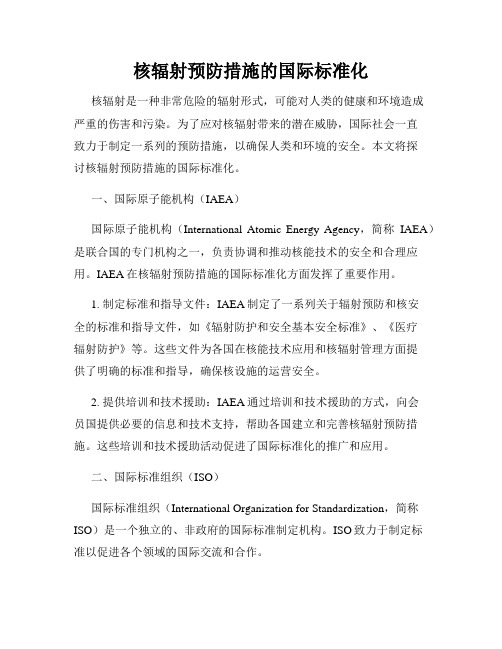
核辐射预防措施的国际标准化核辐射是一种非常危险的辐射形式,可能对人类的健康和环境造成严重的伤害和污染。
为了应对核辐射带来的潜在威胁,国际社会一直致力于制定一系列的预防措施,以确保人类和环境的安全。
本文将探讨核辐射预防措施的国际标准化。
一、国际原子能机构(IAEA)国际原子能机构(International Atomic Energy Agency,简称IAEA)是联合国的专门机构之一,负责协调和推动核能技术的安全和合理应用。
IAEA在核辐射预防措施的国际标准化方面发挥了重要作用。
1. 制定标准和指导文件:IAEA制定了一系列关于辐射预防和核安全的标准和指导文件,如《辐射防护和安全基本安全标准》、《医疗辐射防护》等。
这些文件为各国在核能技术应用和核辐射管理方面提供了明确的标准和指导,确保核设施的运营安全。
2. 提供培训和技术援助:IAEA通过培训和技术援助的方式,向会员国提供必要的信息和技术支持,帮助各国建立和完善核辐射预防措施。
这些培训和技术援助活动促进了国际标准化的推广和应用。
二、国际标准组织(ISO)国际标准组织(International Organization for Standardization,简称ISO)是一个独立的、非政府的国际标准制定机构。
ISO致力于制定标准以促进各个领域的国际交流和合作。
1. ISO 27001:ISO 27001是信息安全管理体系的国际标准,其中包含了对核能设施的信息安全要求。
通过遵守ISO 27001标准,核能设施可以确保核辐射监测和预防措施的信息安全,防止核材料失窃和滥用。
2. ISO 9001:ISO 9001是质量管理体系的国际标准,可以通过实施ISO 9001标准来确保核辐射预防措施的质量和可靠性。
这将有助于提高核设施的运作效率和管理水平,减小核辐射事故的发生概率。
三、国际电离辐射防护委员会(ICRP)国际电离辐射防护委员会(International Commission on Radiological Protection,简称ICRP)是一个独立的国际组织,致力于提供关于核辐射防护的科学指导和建议。
当前我国核电站辐射防护需要重点考虑和解决的问题

当前我国核电站辐射防护需要重点考虑和解决的问题【摘要】核电站辐射防护是保障核电站运行安全的重要环节。
当前我国核电站辐射防护存在一些问题,包括监测技术水平不高、设备更新不及时、人员培训不足、事故应急预案不完善以及环境监测评估不到位等。
为了解决这些问题,需要提高核电站辐射监测技术水平、加强设备更新、加强人员培训、强化事故应急预案并加强环境监测和评估。
当前我国核电站辐射防护需要整体提升,重点加强技术和设备更新、加强人员培训和事故应急准备。
通过这些举措,可以有效提升我国核电站辐射防护水平,确保核电站的安全运行和辐射防护工作的有效实施。
【关键词】核电站、辐射防护、监测技术、设备更新、工作人员培训、事故应急预案、环境监测、评估、整体提升、技术更新、事故应急准备。
1. 引言1.1 核电站辐射防护的重要性核电站辐射防护的重要性在当今社会变得越发重要。
随着核能在能源领域的广泛应用,核电站辐射防护问题直接关系到人民的生命安全和健康,甚至涉及到国家的安全稳定。
核电站辐射防护的重要性主要体现在以下几个方面:核电站辐射可能对人体健康造成严重危害。
核辐射会对人体细胞结构造成损害,引起各种疾病,包括癌症、遗传异常等。
如果核电站的辐射防护不到位,辐射泄漏事故发生后,可能导致大范围的辐射污染,影响周围居民的生活和健康。
核电站辐射防护关系到国家的安全稳定。
核电站是国家的重要能源基地,一旦核辐射泄漏事故发生,不仅会对周围地区造成严重影响,还会对国家的经济发展和社会稳定带来严重挑战。
加强核电站辐射防护是保障国家安全的关键之一。
核电站辐射防护的重要性不容忽视。
只有加强核电站辐射防护工作,提高监测技术水平,更新设备设施,加强人员培训和应急准备,才能有效减少核辐射事故的发生,保障人民的生命健康和国家的安全稳定。
1.2 当前我国核电站辐射防护存在的问题我国核电站辐射监测技术水平相对滞后,部分核电站存在监测设备老化、监测数据不及时传输等问题,导致对核电站辐射情况的监控不够全面、及时。
国际非电离辐射防护委员会_ICNIRP_的工作现状与未来计划
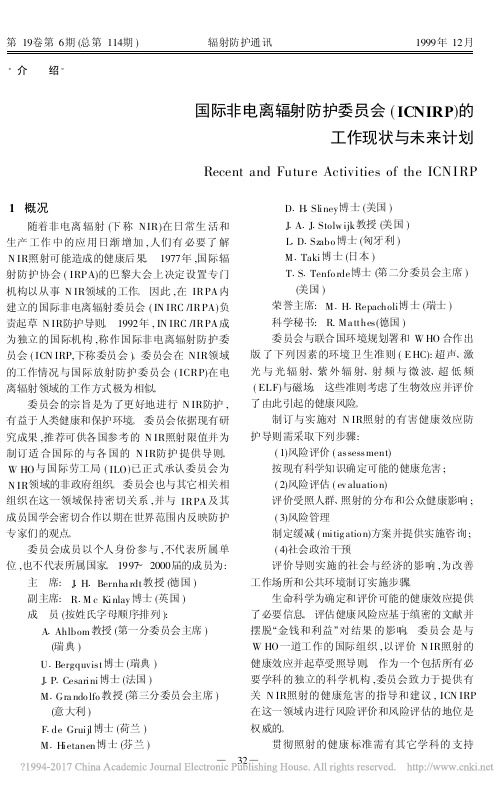
第19卷第6期(总第114期)辐射防护通讯1999年12月·介 绍·国际非电离辐射防护委员会(ICNIRP)的工作现状与未来计划Recent and Future Activities of the ICN IRP1 概况随着非电离辐射(下称NIR)在日常生活和生产工作中的应用日渐增加,人们有必要了解N IR照射可能造成的健康后果。
1977年,国际辐射防护协会(IRPA)的巴黎大会上决定设置专门机构以从事N IR领域的工作。
因此,在IRPA内建立的国际非电离辐射委员会(IN IRC/IRPA)负责起草N IR防护导则。
1992年,IN IRC/IRPA成为独立的国际机构,称作国际非电离辐射防护委员会(ICN IRP,下称委员会)。
委员会在NIR领域的工作情况与国际放射防护委员会(ICRP)在电离辐射领域的工作方式极为相似。
委员会的宗旨是为了更好地进行N IR防护,有益于人类健康和保护环境。
委员会依据现有研究成果,推荐可供各国参考的N IR照射限值并为制订适合国际的与各国的N IR防护提供导则。
W HO与国际劳工局(ILO)已正式承认委员会为N IR领域的非政府组织。
委员会也与其它相关相组织在这一领域保持密切关系,并与IRPA及其成员国学会密切合作以期在世界范围内反映防护专家们的观点。
委员会成员以个人身份参与,不代表所属单位,也不代表所属国家。
1997~2000届的成员为:主 席:J.H.Bernha rdt教授(德国)副主席:R.M c Kinlay博士(英国)成 员(按姓氏字母顺序排列): A.Ahlbom教授(第一分委员会主席) (瑞典) U.Bergquvist博士(瑞典) J.P.Cesarini博士(法国) M.Gra ndo lfo教授(第三分委员会主席) (意大利) F.de Gruijl博士(荷兰) M.H ietanen博士(芬兰) D.H.Sliney博士(美国) J.A.J.Stolw ijk教授(美国) L.D.Szabo博士(匈牙利) M.Taki博士(日本) T.S.Tenfo rde博士(第二分委员会主席) (美国)荣誉主席:M.H.Repacholi博士(瑞士)科学秘书:R.Ma tthes(德国)委员会与联合国环境规划署和W HO合作出版了下列因素的环境卫生准则(E HC):超声、激光与光辐射、紫外辐射、射频与微波、超低频(ELF)与磁场。
医疗照射的防护--ICRP103出版物第七章内容简介及讨论
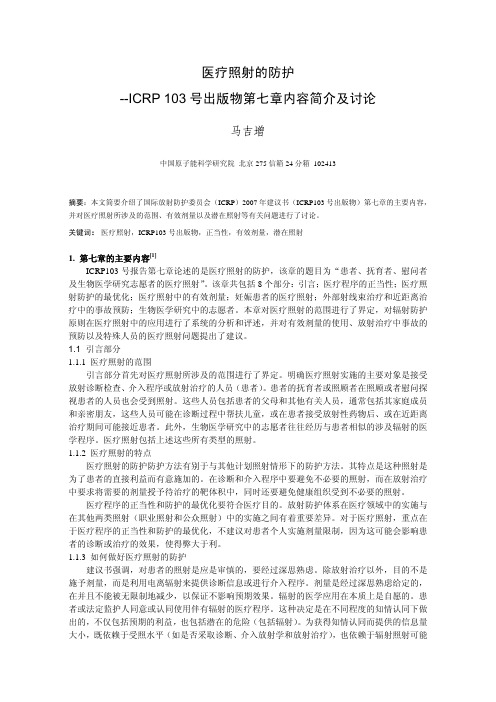
医疗照射的防护--ICRP 103号出版物第七章内容简介及讨论马吉增中国原子能科学研究院北京275信箱24分箱 102413摘要:本文简要介绍了国际放射防护委员会(ICRP)2007年建议书(ICRP103号出版物)第七章的主要内容,并对医疗照射所涉及的范围、有效剂量以及潜在照射等有关问题进行了讨论。
关键词:医疗照射,ICRP103号出版物,正当性,有效剂量,潜在照射1. 第七章的主要内容[1]ICRP103号报告第七章论述的是医疗照射的防护,该章的题目为“患者、抚育者、慰问者及生物医学研究志愿者的医疗照射”。
该章共包括8个部分:引言;医疗程序的正当性;医疗照射防护的最优化;医疗照射中的有效剂量;妊娠患者的医疗照射;外部射线束治疗和近距离治疗中的事故预防;生物医学研究中的志愿者。
本章对医疗照射的范围进行了界定,对辐射防护原则在医疗照射中的应用进行了系统的分析和评述,并对有效剂量的使用、放射治疗中事故的预防以及特殊人员的医疗照射问题提出了建议。
1.1 引言部分1.1.1 医疗照射的范围引言部分首先对医疗照射所涉及的范围进行了界定。
明确医疗照射实施的主要对象是接受放射诊断检查、介入程序或放射治疗的人员(患者)。
患者的抚育者或照顾者在照顾或者慰问探视患者的人员也会受到照射。
这些人员包括患者的父母和其他有关人员,通常包括其家庭成员和亲密朋友,这些人员可能在诊断过程中帮扶儿童,或在患者接受放射性药物后、或在近距离治疗期间可能接近患者。
此外,生物医学研究中的志愿者往往经历与患者相似的涉及辐射的医学程序。
医疗照射包括上述这些所有类型的照射。
1.1.2 医疗照射的特点医疗照射的防护防护方法有别于与其他计划照射情形下的防护方法。
其特点是这种照射是为了患者的直接利益而有意施加的。
在诊断和介入程序中要避免不必要的照射,而在放射治疗中要求将需要的剂量授予待治疗的靶体积中,同时还要避免健康组织受到不必要的照射。
医疗程序的正当性和防护的最优化要符合医疗目的。
X射线探伤辐射防护问题的探讨及改进
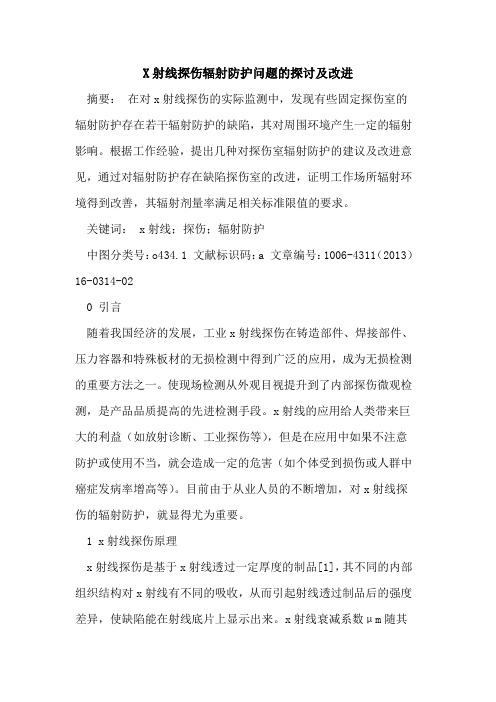
X射线探伤辐射防护问题的探讨及改进摘要:在对x射线探伤的实际监测中,发现有些固定探伤室的辐射防护存在若干辐射防护的缺陷,其对周围环境产生一定的辐射影响。
根据工作经验,提出几种对探伤室辐射防护的建议及改进意见,通过对辐射防护存在缺陷探伤室的改进,证明工作场所辐射环境得到改善,其辐射剂量率满足相关标准限值的要求。
关键词: x射线;探伤;辐射防护中图分类号:o434.1 文献标识码:a 文章编号:1006-4311(2013)16-0314-020 引言随着我国经济的发展,工业x射线探伤在铸造部件、焊接部件、压力容器和特殊板材的无损检测中得到广泛的应用,成为无损检测的重要方法之一。
使现场检测从外观目视提升到了内部探伤微观检测,是产品品质提高的先进检测手段。
x射线的应用给人类带来巨大的利益(如放射诊断、工业探伤等),但是在应用中如果不注意防护或使用不当,就会造成一定的危害(如个体受到损伤或人群中癌症发病率增高等)。
目前由于从业人员的不断增加,对x射线探伤的辐射防护,就显得尤为重要。
1 x射线探伤原理x射线探伤是基于x射线透过一定厚度的制品[1],其不同的内部组织结构对x射线有不同的吸收,从而引起射线透过制品后的强度差异,使缺陷能在射线底片上显示出来。
x射线衰减系数μm随其波长增加和透照材料密度的增加而增大。
由于衰减不同而形成透射x射线强度的差异。
入射强度为i0的x射线通过厚度为d、密度为ρ的物体,输出的x射线强度i与该物体衰减系数μm符合下列关系:i=i0e■x射线探伤机利用射线穿过物质时的减弱规律,在胶片上成像,通过显影和定影处理后形成底片,接收射线越多的部位底片黑化程度越高,据此,可采用射线照相将焊接件、铸件等被检物中的缺陷显现出来,从而确定产品缺陷的位置、大小、形状和种类,确保产品的质量。
2 辐射污染因素及危害固定式x射线探伤的主要污染因素为探伤机工作过程产生的x射线,其污染途径主要是由于探伤室的屏蔽墙和防护门的屏蔽缺陷而导致x射线外泄对外部环境的影响。
《ICRP放射防护体系第4届国际研讨会文集》简介
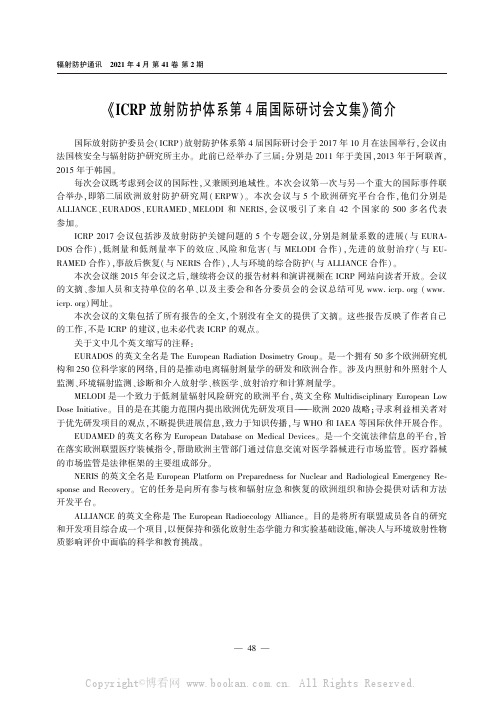
辐射防护通讯㊀2021年4月第41卷第2期‘ICRP放射防护体系第4届国际研讨会文集“简介㊀㊀国际放射防护委员会(ICRP)放射防护体系第4届国际研讨会于2017年10月在法国举行,会议由法国核安全与辐射防护研究所主办㊂此前已经举办了三届:分别是2011年于美国,2013年于阿联酋, 2015年于韩国㊂每次会议既考虑到会议的国际性,又兼顾到地域性㊂本次会议第一次与另一个重大的国际事件联合举办,即第二届欧洲放射防护研究周(ERPW)㊂本次会议与5个欧洲研究平台合作,他们分别是ALLIANCE㊁EURADOS㊁EURAMED㊁MELODI和NERIS,会议吸引了来自42个国家的500多名代表参加㊂ICRP2017会议包括涉及放射防护关键问题的5个专题会议,分别是剂量系数的进展(与EURA-DOS合作),低剂量和低剂量率下的效应㊁风险和危害(与MELODI合作),先进的放射治疗(与EU-RAMED合作),事故后恢复(与NERIS合作),人与环境的综合防护(与ALLIANCE合作)㊂本次会议继2015年会议之后,继续将会议的报告材料和演讲视频在ICRP网站向读者开放㊂会议的文摘㊁参加人员和支持单位的名单㊁以及主委会和各分委员会的会议总结可见(www. )网址㊂本次会议的文集包括了所有报告的全文,个别没有全文的提供了文摘㊂这些报告反映了作者自己的工作,不是ICRP的建议,也未必代表ICRP的观点㊂关于文中几个英文缩写的注释:EURADOS的英文全名是The European Radiation Dosimetry Group㊂是一个拥有50多个欧洲研究机构和250位科学家的网络,目的是推动电离辐射剂量学的研发和欧洲合作㊂涉及内照射和外照射个人监测㊁环境辐射监测㊁诊断和介入放射学㊁核医学㊁放射治疗和计算剂量学㊂MELODI是一个致力于低剂量辐射风险研究的欧洲平台,英文全称Multidisciplinary European Low Dose Initiative㊂目的是在其能力范围内提出欧洲优先研发项目 欧洲2020战略;寻求利益相关者对于优先研发项目的观点,不断提供进展信息,致力于知识传播,与WHO和IAEA等国际伙伴开展合作㊂EUDAMED的英文名称为European Database on Medical Devices㊂是一个交流法律信息的平台,旨在落实欧洲联盟医疗装械指令,帮助欧洲主管部门通过信息交流对医学器械进行市场监管㊂医疗器械的市场监管是法律框架的主要组成部分㊂NERIS的英文全名是European Platform on Preparedness for Nuclear and Radiological Emergency Re-sponse and Recovery㊂它的任务是向所有参与核和辐射应急和恢复的欧洲组织和协会提供对话和方法开发平台㊂ALLIANCE的英文全称是The European Radioecology Alliance㊂目的是将所有联盟成员各自的研究和开发项目综合成一个项目,以便保持和强化放射生态学能力和实验基础设施,解决人与环境放射性物质影响评价中面临的科学和教育挑战㊂84Copyright©博看网 . All Rights Reserved.。
辐射防护的法规与标准

实践经验
标准制定还基于实践经验和对 历史事件的总结分析。
广泛参与
标准的制定过程通常涉及多个 利益相关方的参与和协商,以 确保标准的公正性和可行性。
பைடு நூலகம்
定期更新
标准制定后,会定期进行评估 和更新,以适应科学技术的发
展和新的实践经验。
03
辐射防护法规的执行与监管
法规执行机构与职责
环境保护部门
负责制定辐射防护相关法 规和标准,并监督执行。
辐射防护的法规与标准
• 辐射防护法规概述 • 辐射防护标准解析 • 辐射防护法规的执行与监管 • 辐射防护标准的实践与应用 • 辐射防护法规与标准的挑战与展望
01
辐射防护法规概述
法规定义与目的
定义
辐射防护法规是一套旨在保护人 类免受电离辐射危害的法律和规 定。
目的
确保公众和工作人员的安全,防 止辐射事故和事故发生,并限制 电离辐射的潜在有害影响。
国际原子能机构(IAEA)等国际组织 制定了国际辐射防护标准,各国以此 为基础制定本国的法规。
国内法规
各国根据自身情况制定辐射防护法规 ,可能存在差异。比较不同国家的法 规对于跨国界的辐射防护具有重要意 义。
02
辐射防护标准解析
国际辐射防护标准
国际辐射防护委员会(ICRP)
国际原子能机构(IAEA)
国内辐射防护标准
国家辐射防护标准
各国政府根据国际辐射防护标准和本国实际情况,制定符合 本国国情的辐射防护标准。
地方辐射防护标准
某些地区或城市可能根据自身实际情况制定更加严格的辐射 防护标准。
标准制定依据与流程
01
02
03
04
科学依据
如何理解ICRP新建议书的剂量限制体系

三哩岛事故和切尔诺贝利事故使人们认识到有必要将事 故作为常规运行中的一部份而在防护体系中予以考虑。
ICRP新建议书报告会,北京,2008年11月10-13日
如何实际提高防护水平
ICRP第26号出版物
一方面,科学技术的发展不断地改进防护水平,但这种 改进却是一个渐进过程
另一方面,实际的照射水平是由防护的最优化过程确定 的,因而降低剂量限值并不能明显地降低实际的剂量水平
“危害”是指红斑、脱发和白血球降低等确定效应。
IXPRC这一剂量限制体系一直沿用到二战战后。 美国的曼哈顿计划基本上是在该体系下实施的。
ICRP新建议书报告会,北京,2008年11月10-13日
早期的控制方法
1950年IXPRC改组,更名为ICRP,并发表了以“关键器官” 概念为基础的剂量限制体系,并用“容许剂量”取代了“耐 受剂量”。
后来也证实,电离辐射不仅可使大多数人体组织,而 且也发现植物和动物的生殖组织受到照射后也会对其后代 产生效应。
ICRP新建议书报告会,北京,2008年11月10-13日
早期的控制方法
1898年,奥地利
全世界第一个 控制电离辐射的官方法规
1913年,德国伦琴射线学会 1915年和1921年,英国伦琴射线学会 1922年,美国伦琴射线学会
颁布了建议书
ICRP新建议书报告会,北京,2008年11月10-13日
早期的控制方法
早期这些建议书,推荐了如今众所周知: “距离”-设置电离辐射屏蔽 “时间”-限制照射时间的防护措施
以不发生红斑等急性效应为原则
ICRP新建议书报告会,北京,2008年11月10-13日
早期的控制方法
1928年国际X射线及镭防护委员会(IXPRC)成立 公布了她的第一个建议书,采用“耐受剂量”的概念, 其值规定为“红斑剂量”的一个份额限制照射。 人类第一次正式采用“剂量”定量控制电离辐射的有 害效应。
辐射防护中经常遇到的几个问题_宋文杰
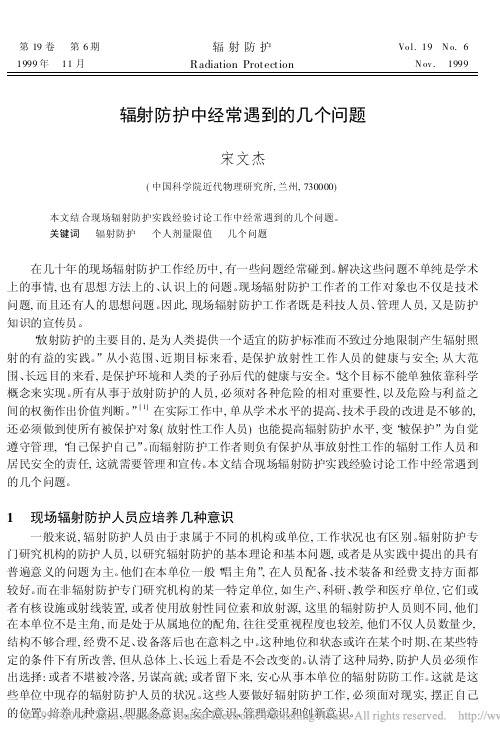
第19卷 第6期辐射防护Vo l.19 N o.6 1999年 11月Radiation Protection N ov. 1999 辐射防护中经常遇到的几个问题宋文杰(中国科学院近代物理研究所,兰州,730000) 本文结合现场辐射防护实践经验讨论工作中经常遇到的几个问题。
关键词 辐射防护 个人剂量限值 几个问题在几十年的现场辐射防护工作经历中,有一些问题经常碰到。
解决这些问题不单纯是学术上的事情,也有思想方法上的、认识上的问题。
现场辐射防护工作者的工作对象也不仅是技术问题,而且还有人的思想问题。
因此,现场辐射防护工作者既是科技人员、管理人员,又是防护知识的宣传员。
“放射防护的主要目的,是为人类提供一个适宜的防护标准而不致过分地限制产生辐射照射的有益的实践。
”从小范围、近期目标来看,是保护放射性工作人员的健康与安全;从大范围、长远目的来看,是保护环境和人类的子孙后代的健康与安全。
“这个目标不能单独依靠科学概念来实现。
所有从事于放射防护的人员,必须对各种危险的相对重要性,以及危险与利益之间的权衡作出价值判断。
”[1]在实际工作中,单从学术水平的提高、技术手段的改进是不够的,还必须做到使所有被保护对象(放射性工作人员)也能提高辐射防护水平,变“被保护”为自觉遵守管理,“自己保护自己”。
而辐射防护工作者则负有保护从事放射性工作的辐射工作人员和居民安全的责任,这就需要管理和宣传。
本文结合现场辐射防护实践经验讨论工作中经常遇到的几个问题。
1 现场辐射防护人员应培养几种意识一般来说,辐射防护人员由于隶属于不同的机构或单位,工作状况也有区别。
辐射防护专门研究机构的防护人员,以研究辐射防护的基本理论和基本问题,或者是从实践中提出的具有普遍意义的问题为主。
他们在本单位一般“唱主角”,在人员配备、技术装备和经费支持方面都较好。
而在非辐射防护专门研究机构的某一特定单位,如生产、科研、教学和医疗单位,它们或者有核设施或射线装置,或者使用放射性同位素和放射源,这里的辐射防护人员则不同,他们在本单位不是主角,而是处于从属地位的配角,往往受重视程度也较差,他们不仅人员数量少,结构不够合理,经费不足、设备落后也在意料之中。
医用辐射防护中的热点与新问题

放射治疗中时间剂量因子(TDF)已经困扰了放射治疗将近一个世纪,上世纪末本世纪初形成的立体定向治疗(SRS、SRT)和正在发展的调强适形治疗(IlVIRT)取得的临床经验,以及放射敏感性检测技术的进展,有可能给放射治疗学界提供关于最佳TDF方案的有益的启示。
医用辐射防护中的热点及新问题张良安(中国医学科学院放射医学研究所天津,300192)目前的医用辐射防护研究已远远超出了单纯的职业人员和病人的防护范畴,而是将其与新的放射治疗技术融合在一起,它不但深化了辐射防护研究,而且成为了推动新治疗技术发展的重要动力,也成为了目前医用辐射防护中的热点及新问题。
在这方面的研究中,最具代表性的是导向治疗、腔内和间质放射治疗中的辐射防护研究。
这里将综合目前国际上和我们的一些研究结果列这些热点问题进行一些讨论。
1、导向治疗中的剂量学新问题1.1细胞和亚细胞水平的不均匀分布在核素治疗中,一般是假设核素在器官内的分布是均匀的,从而用MIRD模式对其病人的剂量进行估算。
但在导向靶向治疗中,由于核素及其载体、器官、细胞等各方面的影响因素,均匀分布这一假设难以满足。
这时需要对细胞和亚细胞水平的微剂量进行研究,通过微剂量分布研究,可以发现放射性药物在细胞和亚细胞水平的非均匀分布。
口导向载体不同引起的非均匀分布有人用1251标记的TNT一1和Lym.1两种单克隆抗体,注射到荷有人淋巴瘤或ME一180宫颈癌的裸鼠体内,分别于不同的时间作光镜放射自显影,发现1251.TNT一1最后主要集中分布在瘤中心的坏死细胞及其周围。
而1251一Lym.1则主要分布在肿瘤周围及瘤内血管周围的瘤细胞上。
口随注入抗体时间不同引起的非均匀分布有人运用光镜放射自显影,观察1251—17—1一A在鼠荷有的人类MAWI移植瘤内的分布情况,发现注入抗体24小时,主要分布在瘤内的维管组织核心及瘤基底膜周围;而72小时,除分布在基底膜上外,还分布在肿瘤细胞表面及腺腔表面上。
核辐射防护技术应用中常见问题解析
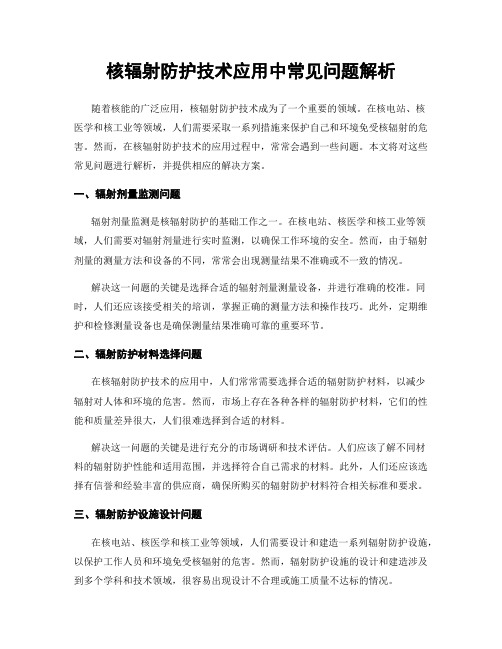
核辐射防护技术应用中常见问题解析随着核能的广泛应用,核辐射防护技术成为了一个重要的领域。
在核电站、核医学和核工业等领域,人们需要采取一系列措施来保护自己和环境免受核辐射的危害。
然而,在核辐射防护技术的应用过程中,常常会遇到一些问题。
本文将对这些常见问题进行解析,并提供相应的解决方案。
一、辐射剂量监测问题辐射剂量监测是核辐射防护的基础工作之一。
在核电站、核医学和核工业等领域,人们需要对辐射剂量进行实时监测,以确保工作环境的安全。
然而,由于辐射剂量的测量方法和设备的不同,常常会出现测量结果不准确或不一致的情况。
解决这一问题的关键是选择合适的辐射剂量测量设备,并进行准确的校准。
同时,人们还应该接受相关的培训,掌握正确的测量方法和操作技巧。
此外,定期维护和检修测量设备也是确保测量结果准确可靠的重要环节。
二、辐射防护材料选择问题在核辐射防护技术的应用中,人们常常需要选择合适的辐射防护材料,以减少辐射对人体和环境的危害。
然而,市场上存在各种各样的辐射防护材料,它们的性能和质量差异很大,人们很难选择到合适的材料。
解决这一问题的关键是进行充分的市场调研和技术评估。
人们应该了解不同材料的辐射防护性能和适用范围,并选择符合自己需求的材料。
此外,人们还应该选择有信誉和经验丰富的供应商,确保所购买的辐射防护材料符合相关标准和要求。
三、辐射防护设施设计问题在核电站、核医学和核工业等领域,人们需要设计和建造一系列辐射防护设施,以保护工作人员和环境免受核辐射的危害。
然而,辐射防护设施的设计和建造涉及到多个学科和技术领域,很容易出现设计不合理或施工质量不达标的情况。
解决这一问题的关键是进行全面的设计规划和施工管理。
人们应该充分考虑辐射防护设施的功能需求和使用环境,确保设计合理、施工质量可靠。
同时,人们还应该加强与相关专业人员的沟通和合作,确保辐射防护设施的设计和建造符合相关标准和要求。
四、辐射事故应急处理问题尽管在核辐射防护技术的应用过程中,人们采取了一系列措施来预防辐射事故的发生,但是事故仍然是无法完全避免的。
实施ICRP建议的主要挑战
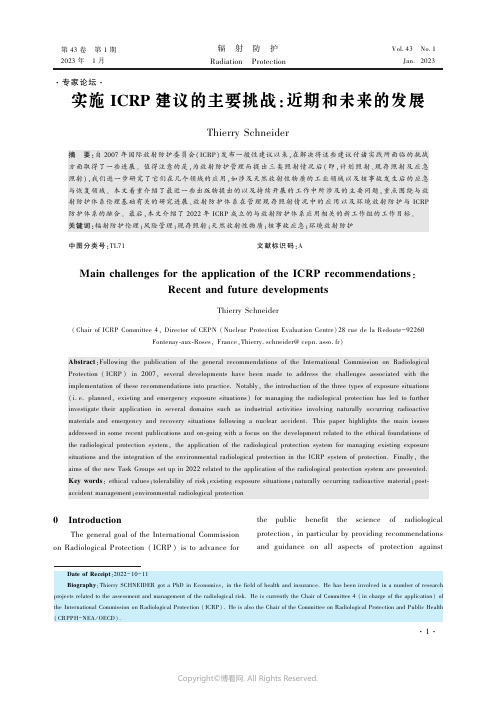
㊀第43卷㊀第1期2023年㊀1月㊀辐㊀射㊀防㊀护Radiation㊀ProtectionVol.43㊀No.1㊀㊀Jan.2023㊃专家论坛㊃实施ICRP 建议的主要挑战:近期和未来的发展Thierry Schneider㊀摘㊀要:自2007年国际放射防护委员会(ICRP )发布一般性建议以来,在解决将这些建议付诸实践所面临的挑战方面取得了一些进展㊂值得注意的是,为放射防护管理而提出三类照射情况后(即,计划照射㊁现存照射及应急照射),我们进一步研究了它们在几个领域的应用,如涉及天然放射性物质的工业领域以及核事故发生后的应急与恢复领域㊂本文着重介绍了最近一些出版物提出的以及持续开展的工作中所涉及的主要问题,重点围绕与放射防护体系伦理基础有关的研究进展㊁放射防护体系在管理现存照射情况中的应用以及环境放射防护与ICRP 防护体系的融合㊂最后,本文介绍了2022年ICRP 成立的与放射防护体系应用相关的新工作组的工作目标㊂关键词:辐射防护伦理;风险管理;现存照射;天然放射性物质;核事故应急;环境放射防护中图分类号:TL71文献标识码:AMain challenges for the application of the ICRP recommendations :Recent and future developmentsThierry Schneider(Chair of ICRP Committee 4,Director of CEPN (Nuclear Protection Evaluation Centre)28rue de la Redoute -92260Fontenay-aux-Roses,France,Thierry.schneider@cepn.asso.fr)Abstract :Following the publication of the general recommendations of the International Commission on RadiologicalProtection (ICRP )in 2007,several developments have been made to address the challenges associated with theimplementation of these recommendations into practice.Notably,the introduction of the three types of exposure situations (i.e.planned,existing and emergency exposure situations)for managing the radiological protection has led to further investigate their application in several domains such as industrial activities involving naturally occurring radioactivematerials and emergency and recovery situations following a nuclear accident.This paper highlights the main issues addressed in some recent publications and on-going with a focus on the development related to the ethical foundations of the radiological protection system,the application of the radiological protection system for managing existing exposuresituations and the integration of the environmental radiological protection in the ICRP system of protection.Finally,theaims of the new Task Groups set up in 2022related to the application of the radiological protection system are presented.Key words :ethical values;tolerability of risk;existing exposure situations;naturally occurring radioactive material;post-accident management;environmental radiological protection㊀㊀Date of Receipt :2022-10-11Biography :Thierry SCHNEIDER got a PhD in Economics,in the field of health and insurance.He has been involved in a number of researchprojects related to the assessment and management of the radiological risk.He is currently the Chair of Committee 4(in charge of the application)ofthe International Commission on Radiological Protection (ICRP).He is also the Chair of the Committee on Radiological Protection and Public Health(CRPPH -NEA /OECD).0㊀IntroductionThe general goal of the International Commissionon Radiological Protection (ICRP )is to advance forthepublicbenefitthescienceofradiologicalprotection,in particular by providing recommendationsand guidance on all aspects of protection against㊃1㊃㊀辐射防护第43卷㊀第1期ionising radiation.Established in1928,ICRP is composed of the Main Commission,the Scientific Secretariat,four Committees,dedicated respectively to effects,doses,medicine and application,and a series of Task Groups.ICRP Committee4provides advice on the application of the Commission s recommendations for the protection of people and the environment in an integrated manner for all exposure situations.The Committee s work combines scientific knowledge,ethical values and practical experience for developing recommendations,communicating advice to a wide range of stakeholders,and preparing advice,taking into account radiological,societal, economic and environmental factors.For the application of the system of radiological protection,two main evolutions were introduced by ICRP Publication103[1]:(1)The removal of the distinction between practices and intervention and the introduction of an approach based on3types of exposure situations (existing,planned and emergency)with the generalization of the optimisation principle in connection with individual dose restrictions(with the use of reference levels and dose constraints)to all controllable exposure situations;(2)The introduction for the first time in the general recommendations of ICRP of the need to account for the views and concerns of stakeholders when optimising protection . Therefore,the application of the system of radiological protection is now structured around the three types of exposure situations(see ICRPædia): (1)Planned exposure situation:An exposure situation resulting from the deliberate introduction and operation of radiation sources,used for their radioactive properties.For this type of situation,the use of the source is understood,and as such the exposures can be anticipated and controlled from the beginning.(2)Emergency exposure situation:An exposure situation resulting from a loss of control of a source, or from intentional misuse of a source,which requires urgent and timely actions in order to avoid or mitigate exposure.(3)Existing exposure situation:An exposure situation resulting from a source that already exists, with no intention to use the source for its radioactive properties,before a decision to control the resulting exposure is taken.Decisions on the need to control the exposure may be necessary but not urgent. The introduction of the new approach with the adoption of three types of exposure situations has led to the development of a series of recommendations to address the application of the system in specific domains.The aim of this paper is to highlight the ICRP Committee4work with a focus on:Ethical foundations;Tolerability and reasonableness; Management of existing exposure situations;and Protection of the environment.In conclusion,some perspectives for future developments in the context of the revision of the general recommendations of ICRP will be addressed.1㊀Ethical values adopted in ICRP Publication 138㊀㊀In2013,acknowledging that radiological protection is not only a matter of science,but also a matter of philosophy and morality as already emphasized by Lauriston Taylor in the1950s[2], ICRP has set up a dedicated Task Group on the ethical foundations of the radiological protection system,with the purpose of improving its understanding and providing a basis for communication on radiation protection.This Task Group worked in close cooperation with several international organisations(IRPA,NEA,WHO, )and selected4core ethical values to encompass the main ethical issues: Beneficence/non-maleficence:doing good and avoiding harm;㊃2㊃㊀㊀/Main_PageThierry Schneider:Main challenges for the application of the ICRP recommendations:Recent and future developments㊀Prudence:in the face of uncertainty,avoid unwarranted risks;Justice:fair sharing of benefits and risks; Dignity:respect of individual autonomy.In addition,3key procedural ethical values have been emphasized underlying the requirements for the practical implementation of the radiological protection system: Accountability:to be responsible for one s own action;Transparency:to share available information; Inclusiveness:stakeholder participation.1.1㊀Beneficence and non-maleficence㊀㊀The ethical value of beneficence refers to doing or promoting good while non-maleficence refers to avoiding causing harm.These values have been largely developed in biomedical ethics[3-4].By developing recommendations seeking to protect people against the harmful effects of radiation,ICRP undoubtedly contributes to serving the best interest of individuals and indirectly the quality of social life[5]. In practice,the aim for ICRP is to ensure that deterministic effects are avoided and the likelihood of stochastic effects is reduced as far as achievable given the prevailing circumstances.In this perspective,the final aim for implementing the radiological protection system is to promote the well-being of people and the environment.For this purpose,the meaning of health refers to the definition provided by WHO: Health is a state of complete physical, mental and social well-being and not merely the absence of disease or infirmity [6].A key challenge for the application of the ethical values of beneficence and non-maleficence in radiological protection is to evaluate the benefits, harms and risks.It requires considerations on individual and societal aspects and adopting a public health approach as well as integrating multi-hazard assessment.By considering a variety of social, psychological,and cultural aspects,it is necessary to balance these various factors and to discuss with all stakeholders how to value and weight them.Special considerations have to be devoted to the evaluation of potential harms and benefits for future generations and the environment.1.2㊀Prudence㊀㊀The ethical value of prudence aims at avoiding unwarranted risks,in the face of uncertainty.It is defined as the ability to make informed and carefully considered choices without the full knowledge of the scope and consequences of actions[5].This value refers to practical wisdom corresponding to the quality of having knowledge,experience,and good judgement to take reasonable decisions and to act accordingly.The value of prudence has a long tradition and was already a key value for the Greek philosophers.More recently,in the context of environmental protection,this value has been disseminated through the precautionary principle [7]. Although there is solid scientific evidence for the foundation of the system of radiological protection, there are still remaining uncertainties for the risk associated with exposures at low levels.This situation requires value judgements.Therefore,prudence is adopted in connection with the different types of effects:For deterministic effects: It is prudent to take uncertainties in the current estimates of thresholds for deterministic effects into account.For stochastic effects in general: the Linear Non-Threshold model remains a prudent basis for radiological protection at low doses and low dose rate.For heritable effects in particular ICRP: prudently continues to include the risk of heritable effects in its system of radiological protection. However,the application of the value of prudence has not to be taken to be synonymous with over-conservatism or never taking risks.1.3㊀Justice㊀㊀The ethical value of justice refers to the fair sharing of benefits and risks.ICRP has distinguished several types of justice for the application of this ethical value in the radiological protection system[5]:㊃3㊃㊀辐射防护第43卷㊀第1期Distributive justice,corresponding to fairness in the distribution of advantages and disadvantages among groups of people; Restorative justice,corresponding to fairness in compensation for losses; Procedural justice,corresponding to fairness in the rules and procedures in the decision-making processes,referring to the right of citizens to participate in these processes.The first issue for the application of the ethical value of justice is to limit individual exposures in order to correct possible disparities in the distribution of health risks due to radiation among exposed populations.This issue refers to the concept of equity introduced in ICRP Publication26[8],with the optimisation principle.In this perspective,ICRP has adopted dose constraints and reference levels to reduce inequities in the distribution of individual exposures.A specific issue has to be considered for intergenerational distributive justice for the management of radioactive waste:this has been developed in ICRP Publication122[9],emphasizing the preservation of health and environment for future generations with an appropriate transfer of knowledge and resources to ensure their protection.1.4㊀Dignity㊀㊀The ethical value of dignity refers to the respect of individual autonomy.This value was largely developed in the Universal Declaration of Human Rights[10].Dignity is considered as an attribute of the human condition with the idea that something is due to a person because she/he is human.Every individual deserves unconditional respect,whatever age,sex,health,social condition,ethnic origin and religion[5].Personal autonomy is a corollary of human dignity:individuals have the capacity to act freely,i.e.to make uncoerced and informed decisions.The respect for human dignity is notably promoted in radiological protection with regard to the principle of informed consent and right to know for different exposure situations and categories of exposure.This is also largely associated with the promotion of stakeholder involvement and empowerment of individuals to make informed decisions,with regard to situations involving exposure to ionizing radiation.1.5㊀Relationship with the ICRP fundamental ㊀㊀㊀㊀㊀principlesThe application in the radiological protection system of the ethical values identified in ICRP Publication138[5]is connected to the3fundamental principles:justification,optimization and limitation. For the principle of justification,the aim is that any decision that alters a radiation exposure situation should do more good than harm.This is associated with the core ethical values of beneficence and non-maleficence.For the principle of optimisation,the aim is that all exposures should be kept as low as reasonably achievable taking into account economic and societal factors(ALARA)with restrictions on individual exposures to limit inequity between individuals and the need to account for the views and concerns of stakeholders.This is associated with the core ethical values of prudence,justice and dignity.For the principle of limitation,the aim is that the dose of any individual should not exceed the level of exposure considered tolerable for the exposure situation under consideration.This is associated with the core ethical values of beneficence and non-maleficence,justice and dignity.2㊀Tolerability and reasonableness The model of reasonableness and tolerability of radiological risk is a conceptual framework for the implementation of the ICRP principles,largely developed in ICRP Publication60[11].With Publication138[5],specific attention has been devoted to the concepts of reasonableness and tolerability,calling for revisiting their meaning,role and practical implementation in the light of the core ethical values and procedural values.In2019,ICRP has set up a dedicated Task Group(TG114)to㊃4㊃Thierry Schneider:Main challenges for the application of the ICRP recommendations:Recent and future developments㊀review the historical and current perspectives onreasonableness and tolerability in order to consolidate and clarify Publication 103[1]on this issue,and toprepare the considerations and basis needed for development offuturerecommendations.Thefollowingparagraphshighlightthecurrentdevelopments on these concepts.2.1㊀The model of tolerability of risk :historicalperspectives ㊀㊀Although this model has been introduced inPublication 60[11],it should be mentioned thattolerability of risk and reasonableness were already on the agenda of ICRP Publication 1in 1959[12]:the problem in practice is to limit theradiation dose to that which involves a risk that is notunacceptable to the individual and to the population at large.the Commission recommends that all doses bekept as Iow as practicable ,and that any unnecessaryexposure be avoided. .Since then,although the specific wording mayhave changed,the ideas have remained largely thesame.The model of tolerability of risk,introduced in ICRP Publication 60[11]emphasizes the distinctionbetween the level of tolerable risk and unacceptablerisk and relies on the dynamic process of optimisation to reachtheALARAlevel ,referringtoreasonableness (see Figure1).Fig.1㊀Model of tolerability of risk as introducedin ICPR Publication 60Morerecently,ICRPPublication101[13]described the approach to address the implementationof the optimisation process including the involvementof stakeholders and further considerations to be takeninto accounttoelucidatewhatisreasonablyachievable.The definitions adopted in Publication138[5]are:Tolerability is defined as the degree or extent towhich something can be endured.Reasonableness is defined as making rational,informed,and impartial decisions that respect otherviews,goals,and conflicting interests.2.2㊀Evolution of the tolerability of risk andreasonableness framework㊀㊀The recent reflections related to the applicationof the model of tolerability of risk and reasonableness for the different types of exposure situation have emphasized the importance of considering broadly thescope and dynamic of the model and to pay moreattention to the multi-dimension of the characteristics of the concepts of tolerability and reasonableness.Considering the level of individual radiological risk is crucial butappearstoberestrictivefortheapplication of the concepts in contexts where thereference to well-being and societal issues play a keyrole and call for integrating a series of components influencing the well-being beyond the level of individual risk.Tolerability of risk is therefore considered as acombination of individual and societal level of risk(including considerations on the construction of the health detriment [14])togetherwithqualitativejudgement.Reasonableness is not limited to a level ofindividual risk but refers to good judgement,fairness,practicability,moderateness,and appropriateness withthe application of the optimisation principle requiring a deliberativeprocesstoachieveareasonablecompromise with all (informed)stakeholders.In this perspective,it should be mentioned thevarious societal considerations introduced in ICRPPublication 101[13]to be used within the optimizationprocess to achieve the ALARA level:Equity,Abilityto control (measurement,health surveillance,etc.),㊃5㊃㊀辐射防护第43卷㊀第1期Sustainability,Intergenerational considerations,Individual benefit,Social benefit,Level of information/ knowledge held by those exposed and Social trust. Recently,Wieder et al[15]proposed the3Rs approach(see Figure2)to better address the meaning of reasonableness and provide guideline for assessing the degree of reasonableness of exposure situations.This approach emphasizes the role of relationship(with stakeholders,empathy and trust), the role of rationale(with technical,contextual and ethical considerations)and the role of resources(with technological,financial and time considerations).Fig.2㊀The3Rs approach2.3㊀Considerations for deriving radiological criteria ㊀㊀As mentioned in ICRP Publication103[1],the selection of radiological criteria depends on the type of exposure situation and has to be done taking into account the characteristics of the considered exposure situation:the nature of exposure;the benefit from the exposure situation to individuals and society;the practicability of preventing or reducing exposures(i.e.controllability);and past experience.The reflections of the Task Group emphasize the need to favour a bottom-up approach rather than a top-down one,acknowledging the key role of dialogue and stakeholder involvement and considering the specific circumstances and context.Depending on the exposure situation,radiological criteria have to be established at local,national,or international levels, and have to rely on an informed process combining science,values and experience.There is no single or universal value for the level of tolerable risk and reasonableness and there is a possible shade of grey between the level of risk that is or is not tolerable.The comparison between radiological risk and chemical risk can informed the criteria selection process and there is a need to consider the possible evolution of exposure situation as well as societal evolution when selecting the criteria.Notably,it is necessary to have due consideration of vulnerable groups or individuals in this selection process.3㊀Management of existing exposure situations ㊀㊀The introduction of the approach in terms of three types of exposure situations by ICRP Publication103[1]led to the development of several Publications dedicated to the implementation of the general recommendations of ICRP for different examples of existing exposure situations.For these situations,the application of the system relies largely on the adoption of an integrated and graded approach.The main characteristics of existing exposure situations are:No real prospect of an emergency that will lead to tissue reactions;Exposure can be anticipated but its level cannot be anticipated without a characterisation(large variability depending notably on the specific context and individual behaviours);Often involve multi-hazards and radiological risk is rarely dominant;Limited options for management of residues and waste;Potentially high cost of regulation in relation to reduction in exposure.Among the existing exposure situations investigated by ICRP,two are presented hereafter: the management of naturally occurring radioactive material(NORM)and the management of post-accidental situation.3.1㊀Radiological protection from NORM industrial processes㊀㊀With Publication142[16],ICRP has provided recommendations for the application of the radiological protection system for NORM industrial㊃6㊃Thierry Schneider:Main challenges for the application of the ICRP recommendations:Recent and future developments㊀processes,considered as an existing exposure situation.NORM industrial processes refer to a wide range of activities:mining and extractive industries (other than U mines);production of coal,oil,gas; production and use of metals(thorium,niobium, zirconium,titanium );phosphate industry;water treatment;cement production;building materials; etcIndustries involving NORM can be characterized like all existing exposure situations(see above)and are in addition:Identified,very diverse,already on-going, generally large size industries but not one sector in itself;Routine radiation exposures involved for workers and members of the public may be higher than those from well controlled planned exposure situations although they remain at relatively low levels; Subject to regulatory authorisation,but in most of the cases not for radiological protection purpose; Experience in risk management but generally poor radiological protection culture; Ubiquity,variability of exposures;May pose an issue of environmental contamination. For the implementation of the radiological protection system,an integrated and graded approach is recommended.This approach starts with the characterisation of the exposure situation at stake, and then integrates,as necessary,specific radiological protective actions to complement the protection strategy already in place or planned to manage other workplace hazards of NORM industrial processes.Next,the approach relies on the gradation of the protection by selecting relevant Reference Levels(not including radon)for workers and members of the public,generally less than a few mSv/y,or above a few mSv/y in some cases but very rarely exceeding10mSv/y.Finally,appropriate collective and individual protective actions are selected.It has to be mentioned that for workers, being in an existing exposure situation,not all the elements of a radiation protection programme applied for planned exposure situation should be required and that the requisites may be implemented more or less thoroughly.For the public,the implementation of the optimization relies on stakeholder involvement to address their main concerns and empower them in the decision-making processes.Long-term health and environmental surveillances have to be discussed and established with the concerned stakeholders.3.2㊀Management of a post-accidental situation ㊀㊀On the basis of the lessons learned from the management of consequences of the Chernobyl and Fukushima accidents,ICRP published Publication 146in2020with recommendations for managing a large nuclear accident[17].This publication distinguishes between the early phase,the intermediate phase and the long-term phase.For the implementation of the system of radiological protection,the early and intermediate phases are considered as an emergency exposure situation,and the long-term phase as an existing exposure situation. Beyond the recommendations dealing with the management of the emergency phase,specific considerations have been devoted to the transition from the intermediate phase to the long-term phase, emphasizing the key issue of moving from an emergency situation to an existing exposure situation. First of all,it has to be acknowledged that moving from the intermediate phase to the long-term phase relies on a decision taken by the authorities to allow people to live permanently in affected areas. This decision should be taken in close consultation with representatives of the local communities and of all other stakeholders.For this purpose,it is necessary to:Characterize the radiological situation of the environment,foodstuffs,goods,and people; Establish mechanisms for the involvement of local stakeholders in decision-making processes; Set up a system for radiological monitoring of the environment and measurement of individual external and internal doses;Put in place appropriate sustainable mechanisms㊃7㊃㊀辐射防护第43卷㊀第1期(e.g.co-expertise process)to involve affected people in the improvement of their living and working conditions.ICRP emphasizes that individuals have a basic right to decide about their future.In this perspective, the implementation of the co-expertise process is crucial to respond to the challenges associated with the aim of ensuring sustainable working and living conditions for people in affected areas following a nuclear accident.This process(see Figure3)is based on the direct involvement of affected people to characterize their personal radiological situation and that of their community,and to implement actions to protect themselves and improve their quality of life with the support of experts and authorities.Fig.3㊀The co-expertise processThe protection of the public in the long-term phase relies on a set of protective actions that continue and complement actions implemented during the early and intermediate phases like decontamination(including waste management), radiation monitoring,foodstuff management,and health surveillance.The selection of a reference level for the optimisation of protection during the long-term phase is a complex decision that requires a large amount of information and must be informed by societal and ethical value judgements.ICRP recommends,in Publication146[17],to select the reference levels in the lower half of the1to20mSv per year band with the objective to progressively reduce exposures to levels towards the lower end of the band(i.e.1mSv per year)and below if possible.It also recommends that stakeholders confronted with the situation should be involved as much as possible.4㊀Protection of the environment㊀㊀Radiological protection of the environment has been significantly developed since ICRP Publication 91[18]with the objective of improving the integration of the protection of the environment within the whole radiological protection system.The aim of the radiological protection of the environment is defined as follows in Publication103[1]:preventing or reducing the frequency of deleterious effects to a level where they would have a negligible impact on the maintenance of biological diversity,the conservation of species,or the health and status of natural habitats,communities and ecosystems .More recently,ICRP Publication124[19] provides guidance for the assessment of potential impacts on animals and plants,through the concept of representative organisms,within the existing system of radiological protection.It emphasizes the combination of the radiological protection of people together with the radiological protection of the environment by providing an approach for allowing environmental considerations to be included in the identification of the best management options,as part of the optimization process(see Figure4).Fig.4㊀Protection of people and theenvironment ICRP Publication124[19] For this purpose,reference values have been adopted by ICRP for the protection of the㊃8㊃。
医院核医学科辐射防护问题及对策解析

医院核医学科辐射防护问题及对策解析发表时间:2018-02-07T09:21:38.637Z 来源:《医师在线》2017年11月下第22期作者:赵艳[导读] 赋予这一部门充足的管理能力与权限,构建明确且全面的管理制度,从而保障医院辐射防护工作的实效性。
(白银市第一人民医院;甘肃白银730900)摘要:核医学是一种应用核技术实现诊疗的一门学科,在医疗卫生领域中的应用相当广泛,对于许多疾病的诊断与治疗均有决定性作用。
开展核医学必然会涉及到辐射防护的问题。
但是就目前而言辐射防护效果并不是非常理想。
对此,探讨医院核医学科辐射防护问题及对策具备显著意义。
鉴于此,本文就医院核医学科辐射防护问题及对策展开探讨,以期为相关工作起到参考作用。
关键词:医院核医学科;辐射防护;问题及对策1、核医学放射防护中存在的问题1.1、科室布局不合理目前核医学科放射检测技术发展迅猛,各医院纷纷投入大量资金用于核医学科科室的建设和设备的购入等方面;但其科室建设的规范化未得到各大医院的重视,大部分的核医学科室的布局存在着较大问题。
有调查显示,某医院的核医学科室建设不存在明确的分区,虽开展医院皮肤敷贴治疗项目,但未设置皮肤敷贴治疗室;各科室之间的墙体厚度、防护门的屏蔽核算厚度均不符合相关标准。
同时相关调查显示,大部分的科室存在改建的现象,多数是设立在老建筑之内,缺乏科室布局的合理规划,从而导致设备安装困难,防护墙厚度不达标以及科室分区不明确等问题的出现。
因此,核污染在实际核医学检测和治疗工作中频频发生。
1.2、非密封源管理不严在实际工作中非密封源日等效最大操作量往往超出正常工作场所的等级;存放和分装非密封源的高活性区域没有醒目警示标识;日常交接班不严或记录不完整等。
1.3、放射性废物管理不严核医学在诊断、治疗过程中被放射性物质所污染的手套、棉签、敷料、一次性物品等放射性医疗废物没有严格进行分类放置和回收,以及非密封源操作时滞留在空气中的有害物质没有及时排出,造成辐射防护不到位。
国际放射防护委员会建议书
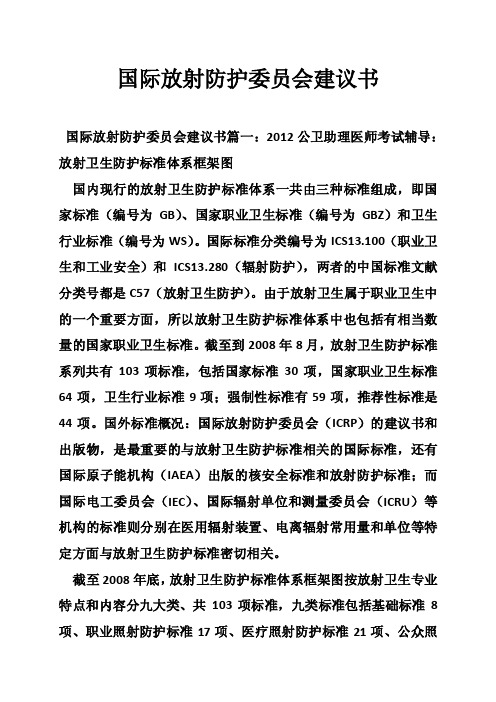
国际放射防护委员会建议书国际放射防护委员会建议书篇一:2012公卫助理医师考试辅导:放射卫生防护标准体系框架图国内现行的放射卫生防护标准体系一共由三种标准组成,即国家标准(编号为GB)、国家职业卫生标准(编号为GBZ)和卫生行业标准(编号为WS)。
国际标准分类编号为ICS13.100(职业卫生和工业安全)和ICS13.280(辐射防护),两者的中国标准文献分类号都是C57(放射卫生防护)。
由于放射卫生属于职业卫生中的一个重要方面,所以放射卫生防护标准体系中也包括有相当数量的国家职业卫生标准。
截至到2008年8月,放射卫生防护标准系列共有103项标准,包括国家标准30项,国家职业卫生标准64项,卫生行业标准9项;强制性标准有59项,推荐性标准是44项。
国外标准概况:国际放射防护委员会(ICRP)的建议书和出版物,是最重要的与放射卫生防护标准相关的国际标准,还有国际原子能机构(IAEA)出版的核安全标准和放射防护标准;而国际电工委员会(IEC)、国际辐射单位和测量委员会(ICRU)等机构的标准则分别在医用辐射装置、电离辐射常用量和单位等特定方面与放射卫生防护标准密切相关。
截至2008年底,放射卫生防护标准体系框架图按放射卫生专业特点和内容分九大类、共103项标准,九类标准包括基础标准8项、职业照射防护标准17项、医疗照射防护标准21项、公众照射防护标准10项、应急准备与响应标准4项、检测规范和检测方法标准34项、防护设施与器材标准5项、管理标准3项和其它标准1项。
国际放射防护委员会建议书篇二:X射线危害及防护X线滥用:最严重的医源性放射损伤近日,江西省一家中医院的病人一天被做10次CT的事件曝光后,在社会上引起关注。
且不说此事件暴露出的乱检查、乱收费等问题,仅病人在短时间内连续接受高强度放射线照射可能会对身体造成巨大伤害的事实,即引起业内专家的关注。
在近日举行的全国第七届儿童发育与临床学术研讨会上,中山大学脑功能影像研究中心主任、中华医学会放射学儿科学组组长叶滨宾教授作了题为“辐射损伤与CT低剂量扫描”的报告,呼吁关注辐射对健康的损害。
ICRP 第六届辐射防护体系国际研讨会(ICRP 2021)
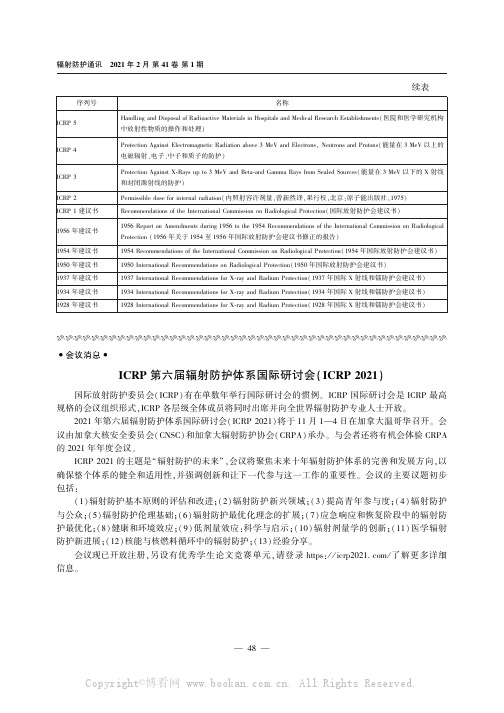
1950 年建议书
1934 年建议书
1928 年建议书
1950 International Recommendations on Radiological Protection(1950 年国际放射防护会建议书)
1934 International Recommendations for X-ray and Radium Protection(1934 年国际 X 射线和镭防护会建议书)
1954 年建议书
1954 Recommendations of the International Commission on Radiological Protection(1954 年国际放射防护会建议书)
1937 年建议书
1937 International Recommendations for X-ray and Radium Protection(1937 年国际 X 射线和镭防护会建议书)
辐射防护通讯 2021 年 2 月 第 41 卷 第 1 期
续表
序列号
名称
Handling and Disposal of Radioactive Materials in Hospitals and Medical Research Establishments( 医院和医学研究机构
ICRP 5
防护新进展;(12) 核能与核燃料循环中的辐射防护;(13) 经验分享。
会议现已开放注册,另设有优秀学生论文竞赛单元,请登录 https: / / icrp2021. com / 了解更多详细
信息。
— 48 —
Copyright©博看网 . All Rights Reserved.
国际放射防护委员会( ICRP) 有在单数年举行国际研讨会的惯例。 ICRP 国际研讨会是 ICRP 最高
辐射防护的全部内容和实践的防护体系——对ICRP新建议书中有关问题的讨论
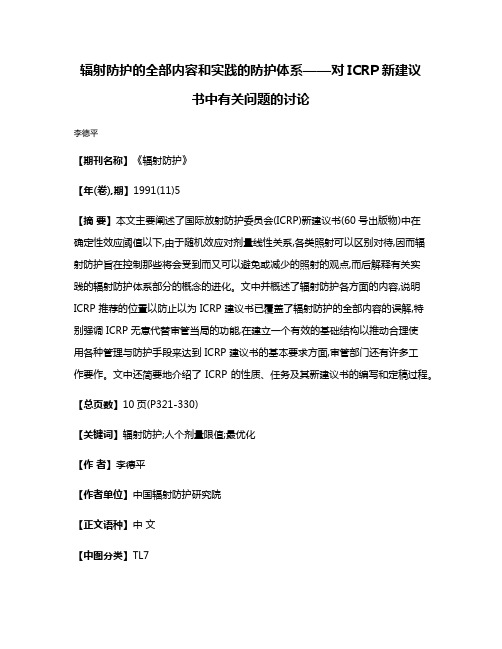
辐射防护的全部内容和实践的防护体系——对ICRP新建议书中有关问题的讨论李德平【期刊名称】《辐射防护》【年(卷),期】1991(11)5【摘要】本文主要阐述了国际放射防护委员会(ICRP)新建议书(60号出版物)中在确定性效应阈值以下,由于随机效应对剂量线性关系,各类照射可以区别对待,因而辐射防护旨在控制那些将会受到而又可以避免或减少的照射的观点,而后解释有关实践的辐射防护体系部分的概念的进化。
文中并概述了辐射防护各方面的内容,说明ICRP 推荐的位置以防止以为 ICRP 建议书已覆盖了辐射防护的全部内容的误解,特别强调 ICRP 无意代替审管当局的功能,在建立一个有效的基础结构以推动合理使用各种管理与防护手段来达到 ICRP 建议书的基本要求方面,审管部门还有许多工作要作。
文中还简要地介绍了 ICRP 的性质、任务及其新建议书的编写和定稿过程。
【总页数】10页(P321-330)【关键词】辐射防护;人个剂量限值;最优化【作者】李德平【作者单位】中国辐射防护研究院【正文语种】中文【中图分类】TL7【相关文献】1.日本辐射防护学界面向ICRP新建议书的讨论 [J], 郭秋菊2.国际放射防护委员会(ICRP)1990年建议书对辐射防护工作可能影响的一些问题的讨论 [J], 潘自强3.区分不同类别的活动及其防护和对潜在照射的防护——对ICRP新建议书中一些问题的讨论 [J], 李德平4.ICRP辐射防护体系修订中若干问题的讨论 [J], 夏益华;刘森林;曲静原5.ICRP新建议书《21世纪初的辐射防护》(草案)专家讨论会在京举行 [J], 刘森林;李玉成因版权原因,仅展示原文概要,查看原文内容请购买。
核与辐射安全法规状态报告

核与辐射安全法规状态报告核与辐射安全问题一直备受全球关注,各国都制定了相关的法规与标准来确保核能和辐射活动的安全性。
本文将就核与辐射安全法规的现状进行探讨,并分析其对于公众、环境以及工作场所安全的保护。
一、国际法规与标准核能与辐射安全的国际法规与标准主要由国际原子能机构(IAEA)和国际电离辐射防护委员会(ICRP)所制定。
其中,IAEA颁布了核安全相关的多项公约,如核不扩散条约(NPT)和权威履约高级别会议(GC)等。
这些公约和条约旨在规范核能的使用和传播,确保核材料不被非法利用。
此外,ICRP也制定了一系列的辐射防护推荐值。
这些推荐值根据最新测试和研究成果,对于不同人群在不同情况下的辐射接触给予了相应的限制和建议。
这些标准的制定,旨在保护人类免受辐射伤害。
二、国家法规与标准各国家和地区都根据自身情况制定了相应的核与辐射安全法规和标准。
美国核管制委员会(NRC)发布了一系列与核能和辐射安全相关的法规,并负责核电站的许可和监管。
在日本,核灾难后,日本政府进行了一系列的修订,完善了核与辐射安全法规。
此外,许多国家还设立了辐射管理机构来监督辐射使用和辐射源的管理。
这些机构负责许可、检查和处罚,并确保核与辐射活动符合法规和标准。
三、核与辐射安全法规的执行与挑战尽管核与辐射安全法规与标准的制定相对完善,但执行和监督仍然面临一些挑战。
首先,核与辐射安全问题的复杂性导致法规的执行难度较大。
核能和辐射的活动涉及多个领域,需要各方的协调和合作。
其次,资源投入与监管不足也是一个问题。
许多发展中国家在核与辐射安全监管方面缺乏经验和技术,资金有限,无法满足监管的需求。
此外,在一些国家,监管机构的独立性不足,可能存在利益冲突或不当影响。
最后,公众对于核与辐射安全问题的担忧和缺乏信任,也对法规的执行造成了阻碍。
信息的不对称和传递的不及时导致了公众的恐慌和猜疑,加深了核与辐射安全问题的困扰。
四、核与辐射安全法规的未来发展为了更好地应对核与辐射安全问题的挑战,未来的法规和标准需要更加全面和前瞻。
- 1、下载文档前请自行甄别文档内容的完整性,平台不提供额外的编辑、内容补充、找答案等附加服务。
- 2、"仅部分预览"的文档,不可在线预览部分如存在完整性等问题,可反馈申请退款(可完整预览的文档不适用该条件!)。
- 3、如文档侵犯您的权益,请联系客服反馈,我们会尽快为您处理(人工客服工作时间:9:00-18:30)。
辐射防护 Radiat ion Pr ot ect io n
Vo l. 22 N o. 6 N ov . 2002
ICRP 辐射防护体系修订中若干问题的讨论
夏益华X 刘森林
( 中国原子能科学研究院, 北京, 102413)
曲静原
( 清华大学核能技术设计研 究院, 北京, 100084)
如: W i = 1 + ( H i - H- ) 2 / HH- 为整个受照人群的个人剂量均值。
6 2) S = W õ H i õN i i
式中, W 为对整个人群的个人剂量分布权重因 子。W 可以取下面的某一种形式: W = H max/ H- , 或 W = 1 + RH ,
或 W = 1 + H max -H- H min 式中, H max 为整个人群中最大个人剂量; H min 为整个人群中最小个人剂量。
提出这种“双轨制”方法的初衷是完全正确 和合理的, 但在实践中带来不少困难和困惑。首 先在对“实践”和“干预”两种活动进行区分, 以 及对其范围进行界定上遇到困难。其次, 不同的 要求和做法引来了很多理解和执行上的困难和 混乱、误解和误用。这也是我们常常听到有人反 映, 感到目前的防护体系太复杂、变得太快、“欺 软怕硬”的主要原因, 由此引发要求简化和统一 体系的想法。 2. 3 集体剂量和危险估计的误用
特别是最近十多年来, 随着冷战时期的结 束, 大批历史遣留问题需要解决, 大批核设施要 退役, 切尔诺贝利事故污染环境需要恢复, 面对 着这样大量的问题, 矛盾就显得更加突出。有报 道, 据不完全统计, 美国有待处理的放射性污染 土壤就有 7 600 多万 m 3[ 2] 。假若由于不恰当地 夸大了对集体剂量和危险度的估计, 而导致废 物处置和环境整治费用过高, 那么所涉及的代 价差异绝对不是一个小数( 假若以 1 000 美元/ m 3 处理费用来估计, 上述污染土壤的总费用达 到 760 亿美元, 那么不同标准所涉及的费用之 间的差别就会是巨大的) 。
核实践历史的核大国, 我们应该积极参与到修 订活动中去, 既要努力了解修订活动的进展, 又 要使我们的意见和观点得到充分的反映。本文 扼要介绍现行 ICRP 辐射防护体系遇到的主要 挑战及作者对体系修订的一些主要意见。
2 挑战的由来
目前的防护体系受到的挑战主要来自以下 几个方面: 2. 1 对线性无阈( LNT) 假定的挑战
等都是优化的有效形式。另外, 优化分析的上界 ( 约束值) 还仍然必须具有审管意义, 不能用“参
· 3 6 2· 辐射防护 第 22 卷 第 6 期
考水平”一类来代替, 因为这样可能导致防护水 平的下降。 3. 4 关于体系的简化
为了避免理解和实施上的困难和混乱, 取 消目前的“双轨制”, 再相对于天然本底照射的 大小, 按辐射危险水平的高低排列为“可忽略”、 “可接受”、“可容忍”和“不可接受”几个剂量区 间( 分别可适用于不同照射情况) , 合成一个统 一的体系, 这种简化处理方法可能是可取的。但 是对于可控制照射的情况所采用的控制水平仍 然必须保持具有 审管含义和限制意义的水平 ( 建议称为“限值”或“限制水平”) 。采用“行动水 平”作为这里的限制水平 可能不合适, 因为按 “行动水平”的定义, 只要低于它, 不管情况如何 都可以不采取行动, 这就有悖于最优化原则, 其 结果必然导致平均剂量的上升和防护水平的下
我们认为, 为了使修改获得更好的效果, 应 该考虑以下几个原则:
( 1) 对现行体系中明显不适合, 过于繁琐 或不一致的地方需要修订;
( 2) 体系的修订总体上不能导致防护水平 的降低;
( 3) 要保持体系的相对稳定性, 不能变得 太快、太大。要知道, 多数国家均尚处在开始全 面推行 ICRP 60 号出版物的阶段, 过快地变更 防护体系可能会带来不良的后果, 也达不到不 断利用科学研究的进展来逐步充实防护体系的 目的。 3. 2 关于集体剂量
针对这些情况, ICRP 主委员会 主 席 Clarke 教 授 已 提 出 过 自 己 的 一 些 建 议[ 3, 4] 。ICRP 也已着手开始新建议书的起草准 备工作。这里, 结合 Clarke 教授的建议, 本着积 极参与的精神谈一些粗浅看法。 3. 1 修改中应考虑的原则
很低的照射剂量在几十万、几百万年内积分, 再 把由此换算出的危害代价和防护代价在几万、 几十万年, 甚至更长时间跨度内进行所谓的优 化分析。还有的把放射治疗中少数受高剂量照 射人员的剂量转移成广大健康人群的平均剂量 等等。这样做的结果往往可以得出许多荒谬的 结论或者天文数字的代价, 当然会引来很多质 疑和批评。
基于对 随机性效应的认 识, ICRP 从其第 26 号出版物开始正式引入了“集体剂量”的概 念, 并且把它作为最优化分析用的一种控制量, 这本来是一种进步。
但相当一段时间以来, 出于多种原因, 使得 在对集体剂量和危险估计方面存在许多误解和 误用的情况, 导致了许多不合理的结论和影响。 例如在计算集体剂量时, 对时间跨度和剂量范 围不加限制, 不分类, 把相差几个量级的剂量混 在一起计算, 把大量无限小累积成了无限大。把
作为一个基本原则仍然需要加以保留, 其 存在的基础为:
( 1) 基于 LN T 假定的自然结果, 当然可能 需要在低剂量处选择一个下限;
( 2) 最优 化实 际上 提供了 一种 “Case by case”的约束, 因此安全与防护最优化可以保证 体系防护水平不下降;
( 3) 满足公众安全要求的提高和竞争加剧 的需要。近十多年来, 公众安全意识普遍提高, 一方面他们希望 核活动产生的照射水平尽量 低, 产生的三废量尽量少, 发生事故的危险尽量 小; 另一方面商业竞争的需要又要求核活动的 成本尽量低。在安全度要求越来越高和成本要 求越来越低这对基本矛盾的推动下, 唯一出路 是全面优化管理, 包括安全与防护的优化。因此 可以说辐射防护最优化也是为了满足社会发展 的需要。
但是我们也必须面对这样一个事实: 随着人类核实践和核活动的不断扩大和深 入, 特别是近十多年来由于冷战时期的结束、大 批核设施的退役、核试验基地和切尔诺贝利事 故后果的处理都使辐射防护开始面临空前复杂 和艰巨的任务, 防护体系的某些不完善环节所 引来的争议日益受到广泛的关注, 所有这些都 使得这次修订显得格外重要。目前, ICRP 已经 全面开始了对 1990 年建议书( 60 号出版物) 的 修订。除了 ICRP 范围内的活动以外, 还有广泛 征求各方面意见的活动。作为已经具有 40 多年
这个假定是 ICRP 根据当时的科学知 识, 对随机性效应作出的一个偏保守的、主要出于 管理目的的假定[ 1] 。这个假定不仅对一定情况 下的危险估计提供了基础, 而且对整个防护体 系具有很大的实际重要性。因为只有在这个假 定下, 才可以对器官内的剂量简单求平均, 才可 以对不同时间内接受的和来自不同照射源的剂 量直接相加, 使得整个剂量计算大大简化。但是 一段时间以来, 不少人对这个假定, 特别是低剂 量范围内这个假定是否合理提出了质疑。因为 按这个假定, 假若不论多么低的剂量都要加以 考虑的话, 有时所需防护代价太高( 这里, 暂且 不讨论有人提出的所谓实现“零排放”的不合理 要求, 因为这种要求并不符合防护体系的基本
摘 要 国际放射防 护委员会 ( ICRP ) 的一系列建 议书为各 国际组织和 国家制定 辐射安全和 防护标准 提供了基础。随着人类核实 践的不断扩大和深入, 防护体系也需要不断完善和改 进。目前, ICRP 已着手 开始对 1990 年建议书的修订工作。本文扼要介绍了现有防护体系遇到的一些主要挑战和作者对体系修 订提出的一些主要意见。 关键词 国际放射防护委员会 辐射防护 防护体系 修订 讨论
现行防护体系出于完全现实的考虑, 把涉 及照射的活动分为两大类, 即:
·拟议中的、继续进行中的活动所产生的 可控制的照射情况, 即实践活动。
·既成事实的、不可控制的照射情况( 包括 历史上遗留下来的放射性残留物, 事故照射, 天 然照射等) , 即干预活动。
防护体系针对这两类在其照射性质、可控 制程度和防护措施可行性等方面截然不同的情 况, 提出了不同的防护要求。总体上讲, 对实践 采用剂量限值的要求, 对干预则采用干预水平 或行动水平的要求。从照射水平上看, 前者如对 公众为每年 1 mSv 的限值要求, 而后者如事故 情况下公众撤离的干预水平则为每周 50 mSv 可避免剂量。公众室内氡的行动水平为每年 3 ~10 m Sv。显然两类要求相差甚远。
在多属性效用分析中, 可以同时引入集体 剂量和某种反映个人剂量分布 的参数, 诸 如: H max , 个人剂量分布参数 RH 2 ( RH 2 为个人剂量 分布的方差) , 或 H max / H- 或 ( H max - H min ) / H等等。
除了要正确计算集体剂量以外, 还要正确 理解最优化的概念, 优化不等于单纯的定量代 价利益分析, 从简单的常识判断, 到优化管理和 简单或复杂的定量分析等都是可用的不同的优 化方法。近年来特别提倡的良好实践、工作管理
2) 剂量 水平要 分组, 时间跨 度不 能太长 ( 对时间跨度的考虑, ICRP 81 号出版物已有建 议[ 5] ) ;
3) 医疗照射作为一个特殊的群体( 照射目 的, 个体健康状况及其差异, 人群大小等方面都 明显特殊) 一般不宜采用集体剂量, 公众照射下 要慎用。职业照射总的来讲仍然是适用的。 3. 3 关于辐射防护最优化
问题是:
( 1) 在集体剂量淡化的情况下, 对什么量 进行优化分析?
( 2) 如何保证个人之间的公平等? 出于我们在 3. 2 节提到的理由, 我们认为 集体剂量对于职业照射和公众照射仍然是有用 的工具, 但鉴于目前也已普遍认识到单纯采用 集体剂量不足以很好地反映危害的大小。可能
应该把个人剂量的分布( 特别是对较高水平的 照射) 的影响同时加以考虑。为此, 我们建议在 代价-利益分析或代价-效能分析中采用以个人 剂量分布参数加权的集体剂量, 而在多属性分 析中可同时采用集体剂量和个人剂量或某个与
